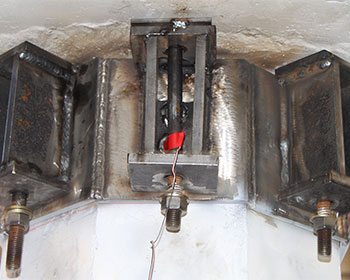

MPC Research Reports |
| Title: | Self-Centering Bridge Bent for Accelerated Bridge Construction |
| Authors: | Chris P. Pantelides and Dipendra Thapa |
| University: | University of Utah |
| Publication Date: | Jul 2021 |
| Report #: | MPC-21-436 |
| Project #: | MPC-545 |
| TRID #: | 01781881 |
| Keywords: | anchors (structural connectors), bents, bridge construction, load tests, precast concrete |
 Precast concrete construction has been proven to be very efficient in bridge engineering, especially in accelerated bridge construction (ABC), where precast concrete components are connected to save time and minimize disruption of traffic. Post-tensioned (PT) concrete structural elements, when combined with energy dissipators (ED), create a hybrid system that ensures self-centering, energy dissipation, and minimum residual drift. This study investigates the connection of precast concrete elements with unbonded post-tensioned bars and stretch length anchors (SLA) and their seismic performance. This study consists of the construction of a precast concrete bridge bent, consisting of two footings, two columns, and a cap beam; the bridge bent was tested under quasi-static cyclic load. The scaled bridge bent is a 42% scale model of the Riverdale Bridge, located over I-80 in Utah. Post-tensioned bars connect the cap-beam, columns, and footings, whereas the SLAs connect the cap-beam to the columns, and the columns to the footings. The SLAs are not part of the existing bridge.
Precast concrete construction has been proven to be very efficient in bridge engineering, especially in accelerated bridge construction (ABC), where precast concrete components are connected to save time and minimize disruption of traffic. Post-tensioned (PT) concrete structural elements, when combined with energy dissipators (ED), create a hybrid system that ensures self-centering, energy dissipation, and minimum residual drift. This study investigates the connection of precast concrete elements with unbonded post-tensioned bars and stretch length anchors (SLA) and their seismic performance. This study consists of the construction of a precast concrete bridge bent, consisting of two footings, two columns, and a cap beam; the bridge bent was tested under quasi-static cyclic load. The scaled bridge bent is a 42% scale model of the Riverdale Bridge, located over I-80 in Utah. Post-tensioned bars connect the cap-beam, columns, and footings, whereas the SLAs connect the cap-beam to the columns, and the columns to the footings. The SLAs are not part of the existing bridge.
The tested bridge bent performed well under cyclic loads with good recentering, minimum residual displacement, good energy dissipation, and minimal damage to the structure. SLAs yielded early and displayed good energy dissipation. Initially, stressed post-tensioned bars played an important role in self-centering of the bridge bent and only yielded at the end of the test. Gap opening in the precast bridge bent avoided damage of concrete in the plastic hinge region.
A computational model was developed and validated with the experimental results to investigate further the application of such a system in full-scale bridges. An elastic perfectly plastic gap material was used to simulate the gap opening phenomenon in the precast post-tensioned system. A force-based beam-column element with fiber sections was used to model the columns, whereas the cap-beam was assumed to remain elastic. SLAs were modeled as tension only bilinear material. Based on the lateral strength, energy dissipation capacity, self-centering capability, and minimum residual drift, the bridge structure was found to be a promising application in high-seismic regions.
Pantelides, Chris P., and Dipendra Thapa. Self-Centering Bridge Bent for Accelerated Bridge Construction, MPC-21-436. North Dakota State University - Upper Great Plains Transportation Institute, Fargo: Mountain-Plains Consortium, 2021.